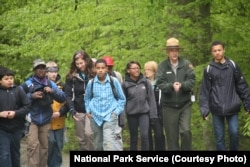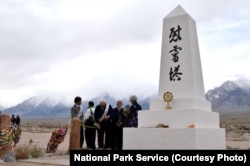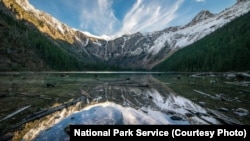Every year, more than 300 million people from around the world visit America’s national parks.
They come to see stunning landscapes like the Grand Canyon and Yosemite, walk among ancient sequoia trees and watch wolves, bison and bears in their natural habitats.
These national treasures, along with thousands of historic buildings, presidential homes, monuments and Civil War battlefields, are found in every state of the union, spread over 32 million hectares from Guam to the Virgin Islands to Alaska — 412 sites in all. They are managed by the U.S. National Park Service, which is celebrating its centennial this year.
“For the last 100 years, the National Park Service has been charged by the U.S. government to manage the very best of America; the very best places that represent both our natural and cultural heritage,” says its director, Jonathan Jarvis. “So, to be part of this organization and to be in the directorship is really a lifelong dream for me.”
Jarvis has been with the National Park Service for 40 years and the director since 2009.
“I like to say the National Park Service is the only federal agency with the responsibility to ensure the public actually has fun!” he says. “So we have a lot of places that are there for the enjoyment of the American people, and visitors from around the world.”
History lessons
Jarvis says it’s also important for visitors to “learn something ... whether it's to learn about nature or plate tectonics or climate change, but also about history.”
That history includes places that tell stories of a darker side of America.
He gives the example of Manzanar National Historic Site in California, a place that tells about the confinement and internment of Japanese-Americans in military-style camps during World War II under an executive order from President Franklin Roosevelt.
“Over 100,000 Japanese-Americans were rounded up at bayonet point and put into prison camps for multiple years during the war just because of their ethnicity,” explains Jarvis. “The Park Service has been charged with telling that kind of story."
An 'honor' to serve
Serving as the director of the National Park Service is a big job, says Jarvis — the agency has 22,000 employees and gets help from 400,000 volunteers — but there's no question it is “an honor.”
“It’s the best job in government, to be in this role, to serve the American people, people of the world and stewarding these incredible places,” he says.
There are fires, volcanoes and floods, he points out. There are First Amendment activities, protests, marches and symbolic activities around issues like the Confederate flag and LGBT rights.
“We participate in all of that," he says, "so that we can help this nation live up to its highest ideals.”
Climate change is real
Another responsibility Jarvis says he must deal with is climate change.
While America's national parks are federally protected, they're not immune to the effects of warmer temperatures.
Jarvis predicts the glaciers in Glacier National Park “to be gone within 20 to 25 years,” and wildfires in the national parks and other public lands are burning "at least a month longer" than in previous years.
As a result of climate change, he says, "the forests are not even coming back in the same way."
In addition, “we’re seeing species being forced to migrate and not necessarily having the corridors to connect between parks and protected areas across the landscape,” he says.
America’s 'cathedrals'
Jarvis has a lot of support to help protect the parks, including from President Barack Obama, who recently spoke at Yosemite National Park.
Using the backdrop of a cascading waterfall, the president spoke of the natural beauty around him.
"Just look at this scene. … You can’t capture it on an iPad, or a flat screen, or even an oil painting. You've got to come here and breathe it in yourself," he said.
"There's something sacred about this place, and I suppose that's why the walls of this valley were referred to as cathedral walls, because here at Yosemite we connect not just with our own spirit, but with something greater. It's almost like the spirit of America itself is right here," he added.
The commander-in-chief used the opportunity to remind everyone about climate change.
“So as we look back over the last 100 years, there’s plenty to celebrate about a national park system that is the envy of the world," he said. "But when we look to the next century, the next 100 years, the task of protecting our sacred spaces is even more important. And the biggest challenge we’re going to face in protecting this place and places like this is called climate change.
“Make no mistake. Climate change is no longer a threat; it is already a reality," Obama added
From Civil War to civil rights
As the National Park Service heads into its second century, Jarvis says new national parks will be “more representative of the contributions of women and minorities” in the U.S.
“So we've added new parks that tell the story of Harriet Tubman, of women's rights, of the LGBT community, of Colonel Charles Young and the Buffalo Soldiers, of Cesar Chavez,” he said.
The Park Service director listed key goals for the future.
"Expanding our story, deepening that story with an existing portfolio, expanding the portfolio to be more representative, and then battling to protect these key natural resources,” he said.
“I hope that the Park Service thrives in its second century, that it is established on a sound foundation of financial support,” he said. “But really the key is the public support, that the public still views the National Park Service as essential.”




